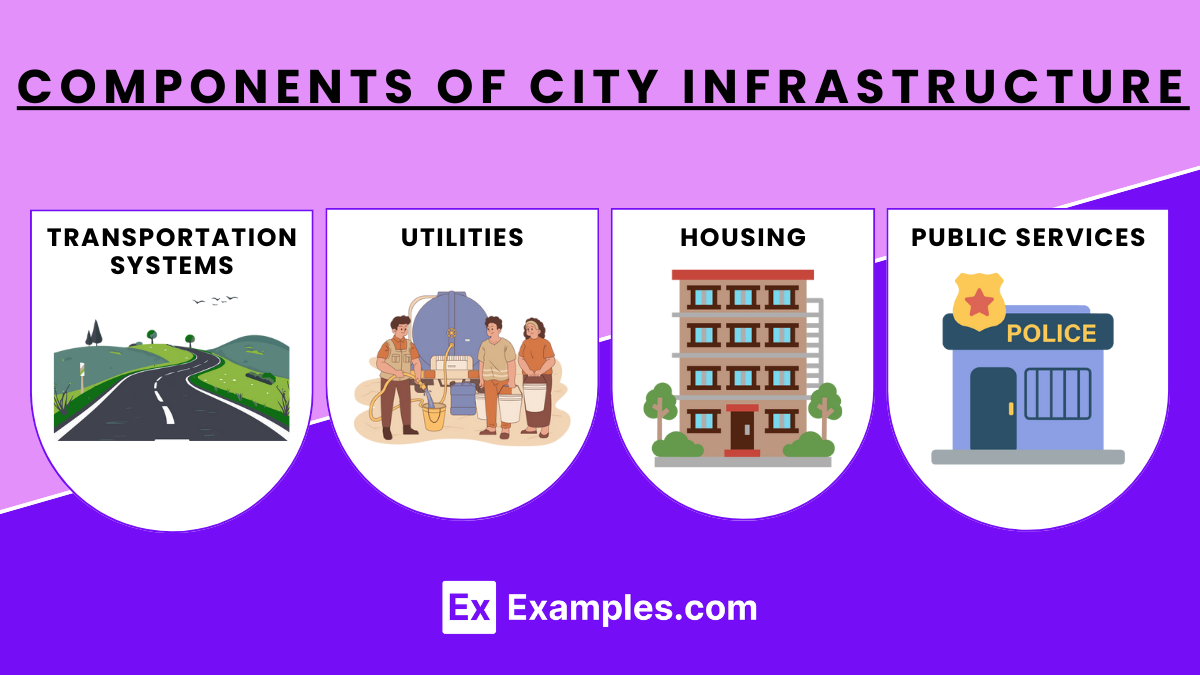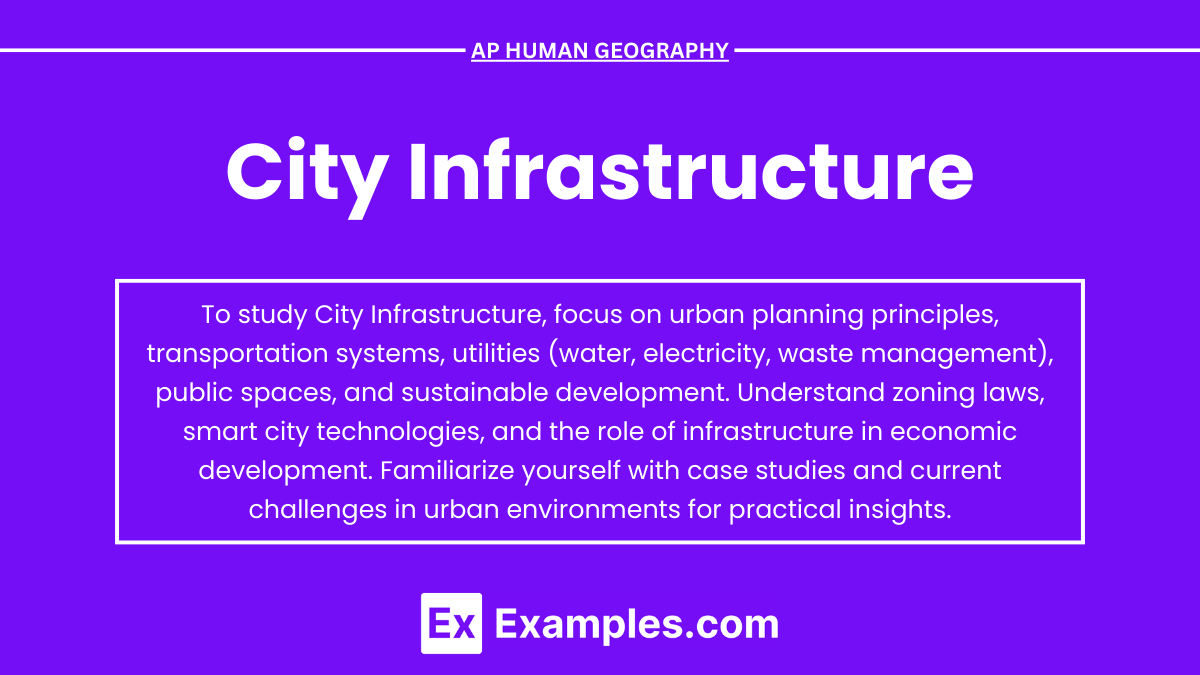City infrastructure plays a vital role in shaping urban environments and enhancing the quality of life for residents. In the context of AP Human Geography, it encompasses the systems and services essential for a city's functioning, including transportation, utilities, housing, and public services. Effective infrastructure supports economic development, social equity, and environmental sustainability. As cities continue to grow and evolve, understanding the intricacies of urban infrastructure becomes crucial for addressing challenges such as urbanization, funding constraints, and equitable access to resources.
Free AP Human Geography Practice Test
Learning Objectives
In studying "City Infrastructure" for AP Human Geography, you should focus on understanding the various components that make up urban infrastructure, including transportation systems, utilities, housing, and public services. Analyze the relationship between infrastructure and urban development, considering factors like sustainability and accessibility. Examine the challenges cities face, such as funding and rapid urbanization, and explore the impact of infrastructure on social equity and quality of life. Additionally, evaluate case studies to illustrate successful and problematic infrastructure projects.
City Infrastructure
City infrastructure refers to the fundamental facilities and systems serving a city, including transportation, utilities, housing, and public services. It is crucial for economic development, quality of life, and urban sustainability. Well-planned infrastructure supports efficient mobility, access to resources, and the overall functionality of urban environments.
Components of City Infrastructure

Transportation Systems:
Roads and Highways: Facilitate the movement of people and goods; the layout impacts traffic patterns, accessibility, and urban sprawl.
Public Transit: Includes buses, subways, and trams; crucial for reducing traffic congestion and promoting sustainable urban living.
Pedestrian and Bicycle Infrastructure: Sidewalks, bike lanes, and pedestrian zones encourage non-motorized transport, enhancing community health and reducing pollution.
Utilities:
Water Supply and Sanitation: Essential for public health; includes water treatment plants, sewage systems, and stormwater management.
Energy Supply: Electricity and gas infrastructure supports residential and commercial needs; renewable energy sources are increasingly integrated.
Waste Management: Systems for collection, recycling, and disposal of waste; affects urban cleanliness and environmental sustainability.
Housing:
Residential Development: Includes single-family homes, multi-family units, and affordable housing initiatives; impacts population density and urban growth patterns.
Urban Renewal and Gentrification: Revitalization of deteriorating areas can lead to improved infrastructure but may displace long-time residents.
Public Services:
Emergency Services: Police, fire, and medical facilities ensure public safety; their distribution affects response times and community well-being.
Education: Schools and libraries are essential for community development and can influence property values and local demographics.
Parks and Recreation: Green spaces contribute to environmental health and provide recreational opportunities, enhancing quality of life.
Challenges in City Infrastructure

Funding and Budget Constraints: Many cities face financial limitations that hinder infrastructure development and maintenance.
Urbanization: Rapid population growth can outpace infrastructure development, leading to congestion, inadequate services, and strained resources.
Environmental Sustainability: Cities must balance infrastructure development with environmental concerns, such as reducing carbon footprints and preserving ecosystems.
Social Equity: Ensuring that infrastructure investments benefit all community members, including marginalized groups, is a significant challenge.
Examples
Example 1: Public Transportation Systems
Public transportation is a vital component of urban infrastructure, facilitating the movement of residents and reducing reliance on private vehicles. Systems like buses, subways, and light rail are essential for connecting neighborhoods to employment centers, educational institutions, and essential services. Cities like New York and Tokyo have extensive public transit networks that not only alleviate traffic congestion but also promote sustainable urban development by reducing greenhouse gas emissions.
Example 2: Water Supply and Sanitation
Effective water supply and sanitation systems are crucial for public health and environmental sustainability. Infrastructure includes pipelines, treatment plants, and sewage systems that deliver clean water and manage wastewater. Cities such as Singapore have implemented advanced water recycling and stormwater management systems to combat water scarcity and protect local ecosystems. Proper sanitation infrastructure is linked to reduced disease transmission and improved quality of life for urban residents.
Example 3: Road Networks
The layout and condition of road networks play a significant role in urban mobility and accessibility. Well-designed road systems can enhance traffic flow and reduce travel times, while poorly maintained roads can lead to congestion and accidents. Cities like Los Angeles have extensive freeway systems, but they also face challenges related to traffic jams and air pollution. The design of road networks influences urban sprawl, land use patterns, and the overall efficiency of a city.
Example 4: Energy Supply Systems
Reliable energy supply infrastructure is essential for powering homes, businesses, and public services. This includes power plants, transmission lines, and local distribution networks. In cities like San Francisco, there is a growing emphasis on integrating renewable energy sources, such as solar and wind power, to create sustainable energy systems. Effective energy infrastructure not only supports economic activities but also contributes to environmental goals by reducing carbon emissions.
Example 5: Parks and Green Spaces
Urban parks and green spaces are critical for enhancing the quality of life in cities. They provide recreational opportunities, promote mental well-being, and contribute to environmental sustainability by improving air quality and reducing heat island effects. Cities like Copenhagen prioritize green infrastructure, integrating parks, community gardens, and green roofs into urban planning. Access to these spaces is essential for social equity, as they offer all residents a place for relaxation, exercise, and community engagement.
Multiple Choice Questions
Question 1
Which of the following best describes the primary purpose of public transportation systems in urban areas?
A) To provide leisure activities for residents
B) To increase property values in urban neighborhoods
C) To reduce traffic congestion and promote accessibility
D) To generate revenue for city governments
Answer: C) To reduce traffic congestion and promote accessibility
Explanation: Public transportation systems are designed primarily to offer efficient and affordable mobility options for residents, thereby reducing reliance on personal vehicles. This alleviates traffic congestion, lowers greenhouse gas emissions, and increases accessibility for those without cars, including low-income populations. While they may contribute to property values and revenue generation indirectly, their main goal is enhancing urban mobility and sustainability.
Question 2
What is a significant impact of urban gentrification on city infrastructure?
A) Improved access to healthcare services for low-income residents
B) Increased investment in public amenities and services
C) Displacement of long-time residents and local businesses
D) Decreased demand for public transportation services
Answer: C) Displacement of long-time residents and local businesses
Explanation: Urban gentrification often leads to the revitalization of neighborhoods, attracting wealthier residents and investment. However, this process frequently results in the displacement of lower-income residents and local businesses unable to afford rising rents and property taxes. While infrastructure improvements may occur (e.g., better roads, parks, and public services), the social consequences can be profound, leading to increased inequality and loss of community identity.
Question 3
Which of the following is a critical component of sustainable urban infrastructure?
A) Expansion of highway systems to accommodate more vehicles
B) Development of green spaces and parks in urban areas
C) Construction of large shopping malls in suburban areas
D) Emphasis on single-family housing developments
Answer: B) Development of green spaces and parks in urban areas
Explanation: Sustainable urban infrastructure focuses on creating environments that enhance the quality of life while minimizing environmental impacts. Green spaces and parks are vital as they provide recreational opportunities, improve air quality, reduce urban heat, and promote biodiversity. Unlike expanding highway systems or suburban shopping malls, which can lead to urban sprawl and increased emissions, developing green infrastructure supports community well-being and sustainable living practices.


